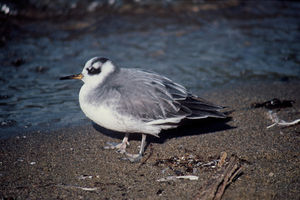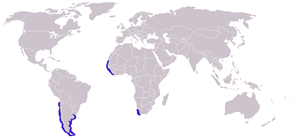Thor's chicken
| Thor's chicken | ||||||||||
|---|---|---|---|---|---|---|---|---|---|---|

Thor's chickens in breeding dress |
||||||||||
| Systematics | ||||||||||
|
||||||||||
| Scientific name | ||||||||||
| Phalaropus fulicaria | ||||||||||
| ( Linnaeus , 1758) |
The Thoroughbred ( Phalaropus fulicaria ) is a species from the genus of the water treaders . It is one of the Arctic snipe birds and can occasionally be observed during its migration time on the German North Sea coast . During this time, however, it wears its simple or resting dress, in which it is very similar to the Odin's hen , which is found there much more often than the Thor's hen individually or in small groups.
The German common name is derived from the Norse god Thor .
Appearance
Brood plumage
The Thor's chicken is characterized by an unmistakable breeding dress. The basic color of the plumage is red, whereas the plumage of the female is of a brighter color than that of the male. The head sides are white. The female wears a black-brown head cap, the male a light brown head cap. The beak is yellow with a black tip, although the proportion of yellow is greater in the female. In the breeding dress, the Thor's chickens can be clearly distinguished from the Odin's chickens, which according to today's common understanding is the second species in the genus of water treaders. The Wilson's treadmill , which was formerly also assigned to this genus, is now usually the only species in the genus Steganopus .
Resting dress
After moulting in the period from August to December, the Thor's chickens change into their resting dress, in which the sexes can no longer be distinguished. The differences to the Odin's chicken are also less obvious now. When resting, the lower body is colored white; The sides of the head are also white and the white on the top of the head usually extends back over the middle of the crown. The back is light gray. It now resembles a Sanderling , but is still differentiated from it by the black head spot behind the eye and its ability to swim.
distribution
Of the two species of the genus of water treaders, the Thoroughbred has the breeding area that is significantly more northerly. It lies on the northern edges of Canada , Alaska, and Siberia, as well as on Greenland , Iceland, and Svalbard . The Thor's chick is a long-distance migrant . Its winter quarters are in the plankton-rich seas off the coasts of South America , West Africa and South Africa .
Way of life
The Thor's chicken is characterized by a way of life that is unusual for birds. The female actively selects the partner and advertises for him in a conspicuous courtship flight. The males also lead the young birds. This behavior is also typical of the Odin's chicken. The reproduction is described in detail in the main article Water Treaders (Birds) .
The food consists of small animals, but if there is a lack of food also of vegetables.
Duration
The total population is estimated at around 920,000 individuals at the beginning of the 21st century. The European population is not very high: 150 to 500 Thor's chickens breed on Greenland, forty to fifty breeding pairs on Iceland and between 200 and 1,000 breeding pairs on Svalbard.
The Thoroughbred is one of the species that will be particularly hard hit by climate change. A research team that, on behalf of the British Environmental Protection Agency and the Royal Society for the Protection of Birds, examined the future development of the distribution of European breeding birds on the basis of climate models assumes that the range of the Thoroughbred will shrink considerably by the end of the 21st century will move east. Most of today's breeding areas on Svalbard will no longer be suitable.
supporting documents
literature
- Hans-Günther Bauer, Einhard Bezzel and Wolfgang Fiedler (eds.): The compendium of birds in Central Europe: Everything about biology, endangerment and protection. Volume 1: Nonpasseriformes - non-sparrow birds. Aula-Verlag Wiebelsheim, Wiesbaden 2005, ISBN 3-89104-647-2 .
- Otto Höhn: The water treaders (Phalaropodidae) . Ziemsen, Wittenberg 1965, ISBN 3-89432-753-7 .
- Josep del Hoyo et al .: Handbook of the Birds of the World. Volume 3: Hoatzin to Auks. Lynx Edicions, 1996, ISBN 84-87334-20-2 .
- Bernhard Grzimek: Grzimeks animal life. Volume 8 ( Birds 2 ). Kindler, 1969, ISBN 3-8289-1603-1 .
- Stanley Cramp , David Snow : The Complete Birds of the Western Palearctic. Oxford University Press, 1998, ISBN 0-19-268579-1 .
Web links
- Phalaropus fulicarius in the endangered Red List species the IUCN 2008. Posted by: BirdLife International, 2008. Accessed January 31 of 2009.
- Videos, photos and sound recordings of Phalaropus fulicaria in the Internet Bird Collection
Single receipts
- ↑ Bauer et al., P. 492.
- ↑ Bauer et al., P. 491.
- ^ Brian Huntley, Rhys E. Green, Yvonne C. Collingham, Stephen G. Willis: A Climatic Atlas of European Breeding Birds. Durham University, The RSPB and Lynx Editions, Barcelona 2007, ISBN 978-84-96553-14-9 , p. 205.



